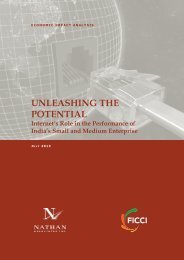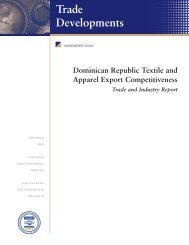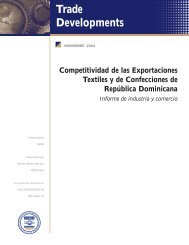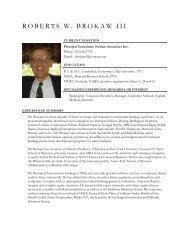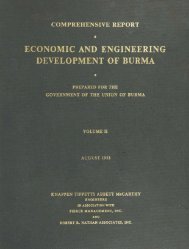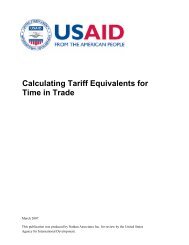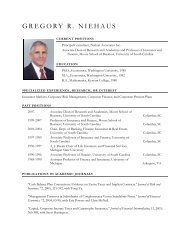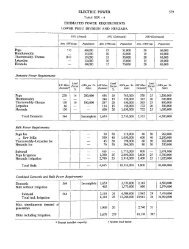Putting it to Work in Developing Countries - Nathan Associates
Putting it to Work in Developing Countries - Nathan Associates
Putting it to Work in Developing Countries - Nathan Associates
Create successful ePaper yourself
Turn your PDF publications into a flip-book with our unique Google optimized e-Paper software.
esources, <strong>in</strong>clud<strong>in</strong>g Internet addresses; and<br />
Appendix C is a glossary of terms related <strong>to</strong><br />
FDI.<br />
FOREIGN DIRECT<br />
INVESTMENT AND THE<br />
DEVELOPMENT MODEL<br />
Economists agree that economic growth drives<br />
development. They do not fully agree on what<br />
drives growth. Some—the “cap<strong>it</strong>al fundamentalists”—assert<br />
that cap<strong>it</strong>al accumulation, through<br />
<strong>in</strong>vestment <strong>in</strong> plant, equipment, and worker<br />
tra<strong>in</strong><strong>in</strong>g and general education, is most important<br />
<strong>in</strong> rais<strong>in</strong>g <strong>to</strong>tal output and output per<br />
worker. Others emphasize the role of “<strong>to</strong>tal fac<strong>to</strong>r<br />
productiv<strong>it</strong>y,” a difficult-<strong>to</strong>-measure bundle<br />
of pos<strong>it</strong>ive variables <strong>in</strong>clud<strong>in</strong>g technology, organizational<br />
methods, and <strong>in</strong>st<strong>it</strong>utions that affects<br />
how well firms and societies can respond <strong>to</strong> economic<br />
opportun<strong>it</strong>ies and <strong>in</strong>centives. 2<br />
Regardless of their pos<strong>it</strong>ions w<strong>it</strong>h<strong>in</strong> this debate,<br />
most parties would probably still agree on the<br />
importance of FDI, for two reasons. First, FDI<br />
has become the dom<strong>in</strong>ant and most reliable<br />
external source of <strong>in</strong>vestment cap<strong>it</strong>al for the<br />
develop<strong>in</strong>g world. And second, FDI delivers this<br />
<strong>in</strong>vestment cap<strong>it</strong>al <strong>in</strong> a way that enhances <strong>to</strong>tal<br />
fac<strong>to</strong>r productiv<strong>it</strong>y.<br />
EXTERNAL CAPITAL FLOWS<br />
One of the most strik<strong>in</strong>g changes <strong>in</strong> <strong>in</strong>ternational<br />
f<strong>in</strong>ance over the last 15 years is the vigorous<br />
expansion of external private cap<strong>it</strong>al flows <strong>to</strong> the<br />
develop<strong>in</strong>g world. In 1990, all net external cap<strong>it</strong>al<br />
supplied <strong>to</strong> develop<strong>in</strong>g countries <strong>to</strong>taled<br />
about $110 billion, made up equally of net private<br />
flows and net official flows (loans and<br />
grants). By 2005, net flows had more than<br />
quadrupled <strong>to</strong> $472 billion, but share distribution<br />
had shifted radically: private cap<strong>it</strong>al ($491<br />
billion) accounted for all external flows <strong>to</strong> the<br />
develop<strong>in</strong>g world, while official cap<strong>it</strong>al had actually<br />
turned negative ($-19 billion) as develop<strong>in</strong>g<br />
country payments <strong>to</strong> official cred<strong>it</strong>ors outstripped<br />
bilateral aid grants received (Table 1-1).<br />
Ireland’s Growth Fueled by FDI<br />
After a decade of susta<strong>in</strong>ed economic<br />
growth, Ireland employed more people<br />
<strong>in</strong> 2004 than at any time s<strong>in</strong>ce <strong>it</strong>s<br />
<strong>in</strong>ception as a State, and enjoys liv<strong>in</strong>g<br />
standards, as measured by gross domestic<br />
product (GDP), that exceed the<br />
European Union average. Its government<br />
<strong>in</strong>debtedness is now the second<br />
lowest <strong>in</strong> the euro-zone. Flows of FDI<br />
<strong>in</strong><strong>to</strong> Ireland fueled this growth. FDI<br />
<strong>in</strong>creased from an annual average of<br />
about $140 million <strong>in</strong> the 1980s <strong>to</strong> a<br />
peak of more than $29 billion by 2002.<br />
As a result, Ireland’s <strong>to</strong>tal <strong>in</strong>ward s<strong>to</strong>ck<br />
of FDI reached $211 billion <strong>in</strong> 2005,<br />
second only <strong>to</strong> Hong Kong <strong>in</strong> per cap<strong>it</strong>a<br />
terms. Throughout this period, the foreign-owned<br />
sec<strong>to</strong>r contributed significantly<br />
<strong>to</strong> growth <strong>in</strong> output, exports, and<br />
employment. And through a multiplier<br />
effect, <strong>it</strong>s prosper<strong>it</strong>y benef<strong>it</strong>ed the<br />
<strong>in</strong>digenous sec<strong>to</strong>r by creat<strong>in</strong>g jobs,<br />
develop<strong>in</strong>g skills, and improv<strong>in</strong>g qual<strong>it</strong>y<br />
<strong>in</strong> general.<br />
Net external private cap<strong>it</strong>al flows consist of FDI,<br />
portfolio equ<strong>it</strong>y, and private commercial debt. 3<br />
Between 1990 and 2005, all three grew significantly<br />
<strong>in</strong> absolute terms. In 1990, net external<br />
private cap<strong>it</strong>al flows <strong>to</strong> the develop<strong>in</strong>g world<br />
<strong>to</strong>taled about $55 billion, made up of FDI ($24<br />
billion, or 43 percent), portfolio equ<strong>it</strong>y ($3 billion,<br />
or 5 percent), and private debt, both longand<br />
short-term loans (more than $28 billion, or<br />
51 percent). In 2005, accord<strong>in</strong>g <strong>to</strong> World Bank<br />
statistics, FDI had <strong>in</strong>creased tenfold <strong>to</strong> $238 billion,<br />
or nearly half of all net private external<br />
cap<strong>it</strong>al, and cont<strong>in</strong>ued <strong>to</strong> represent the largest<br />
s<strong>in</strong>gle flow. Portfolio equ<strong>it</strong>y had risen even more<br />
sharply <strong>to</strong> $61 billion (13 percent of <strong>to</strong>tal),<br />
while private debt <strong>in</strong>creased <strong>to</strong> $192 billion (39<br />
percent). The growth paths of these three flows,<br />
2



